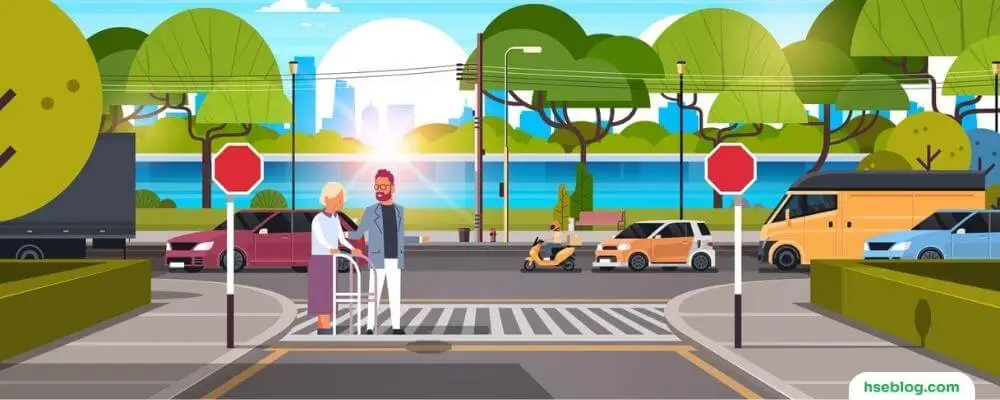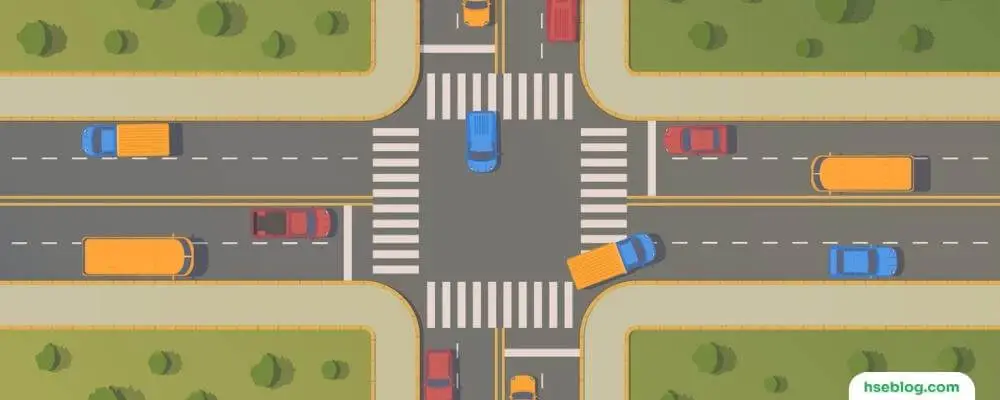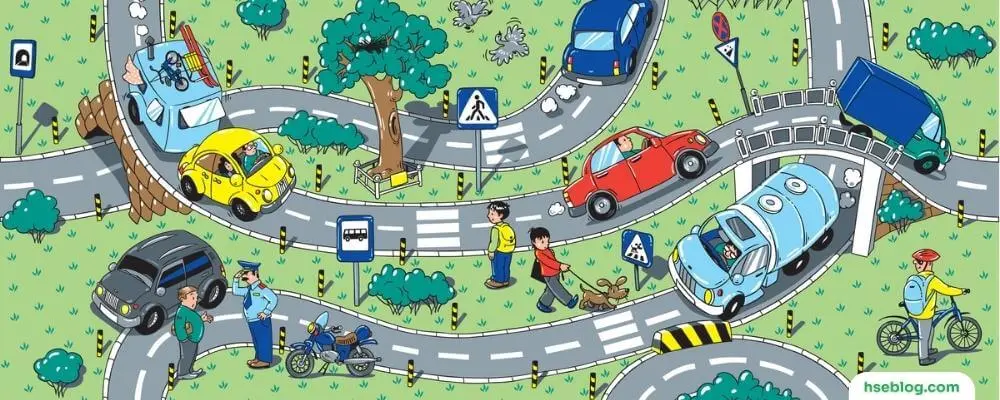Crossing the road can be daunting, especially if you’re unfamiliar with the area. This step-by-step guide will teach you how to cross the road safely and efficiently. Whether in a hurry or taking your time, following these tips will make crossing the road much easier!
Crossing the road seems like an easy, thoughtless activity that we do all the time, but it has the potential to be very dangerous. Whether you’re crossing the road as a pedestrian, a vehicle driver, or a cyclist, you need to know the rules and safest procedures for crossing safely and legally.
General Safety Rules For Crossing the Road
Everyone should follow some basic safety rules when crossing the road. Here are the most important ones:
- Always look both ways before crossing the street, even if there is a traffic light or stop sign.
- Make sure you can see clearly in all directions and that no cars are coming before you start to cross.
- If crossing at a crosswalk, push the button and wait for the walk signal before crossing.
- Don’t assume it can see you just because you can see a car. Make eye contact with drivers as they approach to make sure they see you.
- Be extra careful when crossing at night or in bad weather. Wear bright clothing or reflective gear so drivers can see you more easily.
- Try to cross streets at well-lit intersections whenever possible.
- Don’t dart out into the street from between parked cars. Drivers might not see you until it’s too late.
- If there is no sidewalk, walk facing traffic so drivers can see you coming.
- Don’t use your phone or headphones while crossing the street. You need to be able to hear traffic and be aware of your surroundings.
- Pay attention to what’s happening around you, and don’t cross the street if distracted.
Following these simple safety rules can help prevent accidents and keep you safe when crossing the street. Be sure to teach them to your children so they can stay safe too. Crossing the street may seem simple, but it’s important to be cautious and take your time to do it safely.

Crossing the Road as a Pedestrian
1. Cross Only At Designated Crosswalks
Look for painted lines on the roadway that indicate a safe crosswalk that allows pedestrians to cross the road. In the United States, there will always be painted in white and perpendicular to the road. If you are in another country, you may have a different system; check with your local transportation department for more information.
- Some crosswalks use several rectangular “blocks” of paint to indicate where you should walk across, while others use two parallel lines to designate the crossing area.
- You will typically find crosswalks at an intersection with another road or sometimes in the middle of a block in high foot traffic areas.
2. Initiate An Available Pedestrian Signal
Look for a button to press near a crosswalk that signals the WALK/DON’T WALK pedestrian lights to change. When available, these buttons are necessary to use to cross safely.
- Once you’ve pressed the button to initiate the pedestrian signals, wait patiently on the sidewalk or curb for the signal to change to WALK or whatever symbol is used in your area to indicate it is safe to cross.
- If there is no pedestrian-initiated button, cross with extra caution when the regular traffic light turns green or when vehicles at stop signs see you and allow you to cross.
3. Cross When The Walk Signal Comes On
Cross the road only when the pedestrian signal changes to white letters that say WALK, a white symbol of a person walking, or another symbol used in your area to indicate “walk.” Look both ways down the street to ensure it is safe to cross.
- Always look to your left, and then you’re right; you’ve left again before crossing any road. In the U.S., this helps you see the immediately oncoming traffic in the lane you will walk into first. In countries where traffic is on the left side of the street, you should look right-left-right.
- If both are available, pay attention to the pedestrian signals, not vehicle traffic lights. Just because you see a green traffic light does not necessarily mean you are safe to cross as a pedestrian.
- An orange hand symbol, the words DON’T WALK, or another symbol will begin flashing, or a countdown will begin when your time to cross is running out. Do not cross when you see the static DON’T WALK signal.
- Make eye contact with drivers at the intersection you are crossing in front of to make sure they see you, and you see them if they signal at you in any way. This is especially important for crossing a road with stop signs rather than stop lights.
4. Cross Very Carefully If There Are No Pedestrian Signals
When there are no WALK/DON’T WALK signals for you to cross a street, use extra caution. Stay in the crosswalk and proceed whenever a traffic light turns green or cars at a stop sign see you crossing.
- When at a traffic light intersection, wait till the lights turn green for the vehicles going in the same direction as you. Look both ways and pay attention to any drivers turning into your path.
- When at a stop sign intersection, take special care to make eye contact with the drivers on either side of the street you’re crossing when they are stopped at a stop sign. You may see them “wave you on” or make any other indication that they see you and want you to proceed.
5. Find The Safest Means To Cross With No Crosswalk
If no crosswalk is available in a rural area, go to the nearest intersection or the most well-lit area and proceed to cross cautiously when no oncoming cars exist.
- Ensure that no traffic in either direction or vehicles are very far away before crossing. Look left and right several times before you cross, even in a rural or low-traffic area.
- Crossing a high-speed or high-traffic street, like the frontage road for a highway, is unsafe without a crosswalk at an intersection. In this case, you must walk on the sidewalk to an intersection with stop signs, stop lights or crosswalks. Do not attempt to cross without the assistance of road markings and signals.

Crossing the road as a Driver
1. Pay Attention To Traffic Lights
Obey traffic lights carefully when approaching an intersection controlled by them where you want to cross the road. Follow green for go, yellow for slow, and red for stop.
- Attention to traffic crossing your path, even when the light is green. These could include cars from the cross street that run a red light illegally or vehicles from the other side of the street who make unprotected left turns (or right turns in some countries).
- Gauge when to slow down for yellow lights very carefully. You shouldn’t speed up to cross while the light is still yellow, but you should not abruptly brake right before an intersection and risk causing an accident. Slow down when you can do so safely, or proceed through the yellow light with caution.
2. Obey Right-of-way At Stop Signs
Yield to other drivers when you approach an intersection controlled by one, two, or four stop signs or an uncontrolled intersection with no stop signs at all. Slow down and obey yield signs in the same manner as stop signs when other traffic is present.
- In general, and at four-way stops (all streets have stop signs), any driver should observe right-of-way by letting whoever got there first proceed. If two or more drivers arrive at the stop sign simultaneously, the driver to your right proceeds. If it is still unclear, a driver going straight will proceed first before one turning.
- At a two-way stop or a T-shaped three-way intersection, the driver at a stop sign should always wait for traffic to completely clear on the through street that does not have any stop signs.
- At an uncontrolled intersection, where there are no stop signs, a driver should slow down, be prepared to stop, and wait for any drivers already in the intersection to pass through, then proceed cautiously when no other cars are passing.
3. Cross According To All Other Signs And Signals
Pay attention to any other traffic signs and signals directed at vehicles before you cross a street. You should always proceed according to what’s happening around you, even when signs and signals indicate it’s safe.
- Observe pedestrians closely when proceeding across the street. You might see signs in some areas that alert you to “PED XING” when there is a crosswalk. You should be prepared to slow down and stop.
- Pay attention to other special signs at intersections that could affect how you cross the street, like “Cross traffic does not stop” or markings on the road that indicate things like changing lanes or a bike lane to keep clear of.

Crossing the road as a Cyclist
1. Obey Normal Vehicle Signs And Signals
Follow the same rules that apply to drivers of motor vehicles when crossing any road. Obey any additional signs directed at bicycle riders.
- This means that cyclists should follow green, yellow, and red lights as normal at a traffic light-controlled intersection and observe right-of-way as normal at a stop light-controlled or uncontrolled intersection.
- Pay attention to any signs directed at cyclists specifically. “Use Ped Signal” could indicate that you should cross according to the pedestrian lights rather than the vehicle traffic lights. “To request green, wait on [symbol]” shows you an area to position your bike to initiate a green light and cross the intersection.
2. Stay In The Bike Lane If Available
Keep riding in a bike lane or according to markings on the pavement that indicate where a cyclist should go when crossing the street. In the U.S., you’ll stay in the right lane or the right side of the roadway if there is no bike lane.
- If there is no bike lane and the lane is wide enough, stay alongside cars in the traffic lane before crossing. If the lane is narrower, “take the lane” by positioning yourself in the middle so that no car can attempt to move next to you.
- Change lanes when necessary to proceed straight across the street or turn in the direction you wish to go. For instance, though you may be riding in the right lane, if it becomes a right-turn-only lane at an intersection and you need to proceed straight, you will shift to the left until you are in a lane designated for straight-through traffic.
3. Proceed With Caution To Other Drivers And Pedestrians
Pay close attention to other vehicle drivers and pedestrians in an intersection before crossing. Be aware of your unique position as a transportation that is faster than the pedestrian but smaller and more vulnerable than motor vehicles.
- Be aware that vehicle drivers in the U.S. may not see you on their right side and can make manoeuvres like clipping a corner on a right turn or merging lanes without noticing you, which can endanger you when crossing the street. Position yourself where drivers can see you as best as possible.
- Never try to weave in and out of lanes or vehicles. Only merge into a new lane when necessary to make a turn or other safety manoeuvre, and only after using hand signals appropriately.
- Never cross a street from a sidewalk on a bike, as it will confuse and disrupt drivers and pedestrians. Dismount a bicycle and cross at a crosswalk only if it is safer or necessary.
Conclusion
Road safety is a shared responsibility involving pedestrians, cyclists, and drivers. By adhering to the guidelines outlined in this blog, we can all contribute to making our roads a safer place for everyone. As pedestrians, being vigilant and following the basic rules of crossing roads can make a significant difference. Cyclists should prioritize visibility and respect traffic regulations, while drivers must exercise caution and empathy towards other road users.
Fostering a road safety culture relies on each of us actively participating in and promoting responsible behaviour. By educating ourselves and others, we can not only prevent accidents but also save lives. Let’s commit to making our streets safer by practising the tips discussed in this blog and encouraging our friends, families, and communities to do the same. Together, we can ensure a more secure and enjoyable experience for everyone on the road.

